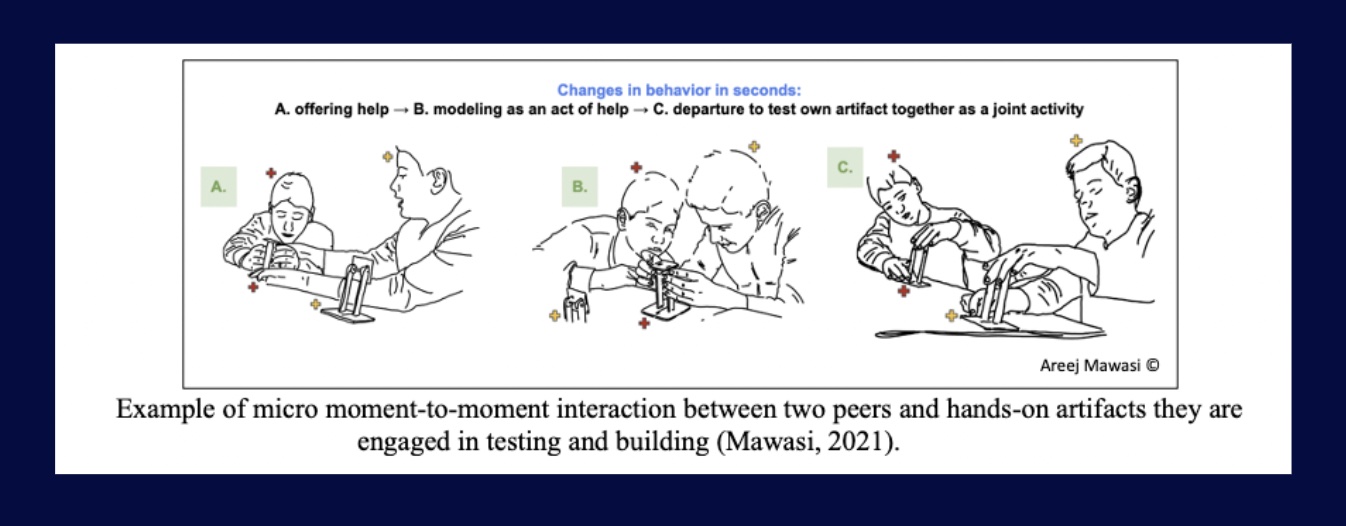In the lab for Co-Design and Interactive Learning, we study, design, and implement learning environments mediated by digital media and technology for and with nondominant learners and communities. Our group addresses the question of how we might design and organize educational experiences that broaden, deepen, and support participation in science and technology for diverse communities. Specifically, how do historically nondominant and minoritized learners engage in STEM learning environments designed to nurture their critical and ethical STEM literacies development of scientific and technology? In what ways technology-rich environments and digital media can mediate this learning process? And what are the conditions that organize learning and interactions in learning environments?

Our group work draws on interdisciplinary research that bridges between the learning sciences, educational technology and digital media, and participatory research. We conduct research and publish work around the following areas of research: sociocultural learning theory, ethics and responsible innovation in STEM education, design research and participatory methodologies, AI and digital media literacies.
Current projects in the lab are focused on:
(1) Towards Critical AI Literacies: Co-design for engagement in critical and ethical perspectives of emerging technologies and digital media (such as AI tools, social media, games, apps).
AI Literac(ies) and the Design of AI Learning Environments
AI in Education is becoming an interest of various educational settings, in and out of schools. There is a growing need to understand the potential of AI for education, how to design for learning about and with AI, and learn about the literacies demands for engaging equitably with such emerging technology in educational settings. This project uses a systematic methodology to examine research on AI learning environments design, ways to expand our conceptualization of AI literacies, and mapping of design principles that guide existing work.
Critical and Ethical Exploration of AI as an Emerging Technology: Co-Design for Supporting Arab Palestinian Learners’ Critical Literacies of Emerging Technologies
We use a Storyline Framework approach towards designing a curricula for engaging learners with critical and ethical explorations of AI technologies that are relevant to their everyday life. We use this framework to explore design methodologies of a culturally informed curricula and to examine ways learners engage with various aspects of our design. We explore learners perceptions of existing technologies and ways to support their digital self-determination through participatory design methods.
Educators perceptions of AI technologies: Towards expanding the affordances framing to support educators imagination
Understanding educators’ views on the potential of AI s is essential for recognizing their needs and hopes for the implementation of such tools in educational settings. By examining how AI tools can be possibly incorporated into education from teachers’ perspectives, researchers can better understand and integrate educators voices and feedback into the development of educational technologies and AI-focused curricula. We are exploring the educators perspectives towards how they imagine their roles in relation to AI and how they imagine the presence of AI technologies in their work.
(2) Learners critical and ethical engagement in STEM: Learners’ engagement in transdisciplinary Science, Technology, Engineering, Art & Math (STEAM) activities through sociocultural and political lens.
Through this work, we seek to address following research questions: How do learners develop their ethical thinking of science and technology innovations? What are value systems that shape learners’ perceptions when engaging with science and technology innovations? How do learners connect between their STEM learning and their everyday life experiences, realities, and histories? Doing this work with nondominant and historically marginalized learners invite us to examine design and pedagogy for incorporating cultural ways of knowing and values of these learners into STEM environments towards supporting their identities and participation in STEM.
(3) Design-based research methods and interaction analysis for understanding learning and design for learning:
Design-based research and participatory methodologies: we take an applied experimental approach in STEM education. We utilize the sociocultural understanding of learning to design interactions, instruction, hands-on activities, and experience mediated by technologies.We draw on participatory design-based research to involve participants (e.g., learners, educators) in the creation of STEM learning environments and artifacts we design. Such an approach democratizes knowledge production and develops agency of participants. We explore how co-design of STEM environments, curriculum, and technology-rich environments can be a space for collaborative knowledge construction and how such a process support participants agency and participation in STEM practices and discourses.
Learners’ micro-analysis of interactions: A multimodal and culturally sensitive analysis is essential for understanding learning processes and interactions evolvement in learning environments. We use microanalytical methods of learning interactions and meaning-making to examine how learning is organized among learners, educators, and artifacts. Micro-analysis serves in understanding the history and future of learning events and in-depth analysis of learners’ interactions with one another and tools in the learning environment.
